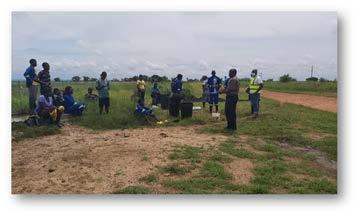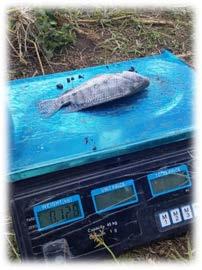
2 minute read
Fish farming part 2: Sampling the catch
from ProAgri Zambia 63
by ProAgri
Sampling is the process of weighing fish to determine the growth rate and performance. Fish sampling involves taking weights and measurements such as body length, and the weight of the fish population. A sample represents an entire population and therefore should be large enough to detect any variations. At farm level, monthly sampling is ideal, although the shorter the time between samplings, the better the results. The best time for sampling is in the morning or evening. At least 5 to 10% of the total population should be sampled to represent the entire population of fish.
Importance of sampling:
Advertisement
• Helps in observing the growth trends of fish. • Helps to estimate the total weight of fish in the water. • Feed depends on the total weight of the fish and therefore, sampling helps to determine the quantity of feed needed for the pond. • Helps to calculate feed utilisation. • Sampling helps to determine the condition of the fish in respect of health status, and growth rate.
What to do before the day of sampling:
It is important to plan well in advance to ensure that the sampling process will be successful. This includes setting the sample date and determining what material and personnel will be required. Make sure you obtain all the required tools for sampling in advance.
Sampling tools include the following:
• Seine net with the proper mesh size. • Fish basket or bucket. • Weighing balance or scale. • 4 large basins.

Count the number of total mortalities before sampling and subtract from the total number at stocking.
Smaller fish nets are used to scoop the fish into buckets.
The Namulela Youth cooperative team.
For example, if the pond was stocked with 5 000 fish, and mortalities were 1 000 before sampling:
Members of the Namulela Youth cooperative team placing the fish into buckets with clean water before weighing and measuring the fish.
5 000 – 1 000 = 4 000 fish Sample size = 5 x 4 000 = 200 100 fish will be sampled.
Sampling procedure:
• Seine/scoop the fish from the pond. • Put the fish into the buckets with clean water. • If weighing the fish individually is not possible, then weigh in groups of 10 or more in the bucket or basin with water, take them out, weigh the bucket and water and subtract from the gross weight.
This can be done until the number of fish required is achieved. • Upon completing the task, calculate the average weight of the fish and estimate the total weight of fish in the pond by multiplying it with the estimated number in the pond.
For example: If 50 fish weigh 2 000 g then the average weight is:
ABW = 2 000 = 40 g 50
When not to sample from a pond:
• When fish are at risk and showing signs of extreme stress. • When there is lightning during a rainstorm. • Directly after rain. • When the water quality is poor.
The Namulela Youth cooperative in the Chanyanya Kafue district scooping fish from the ponds using a seine net with proper size mesh, ensuring that a large enough sample is collected, representing the entire fish population. Sampled fish from the ponds are weighed on an electronic scale. Weighing can be done on either a weighing balance or scale.
For more information on fish sampling contact Rowena Blanco at rowena@tigerfeeds.com.zm or visit the website at www.tigerfeeds.com.










